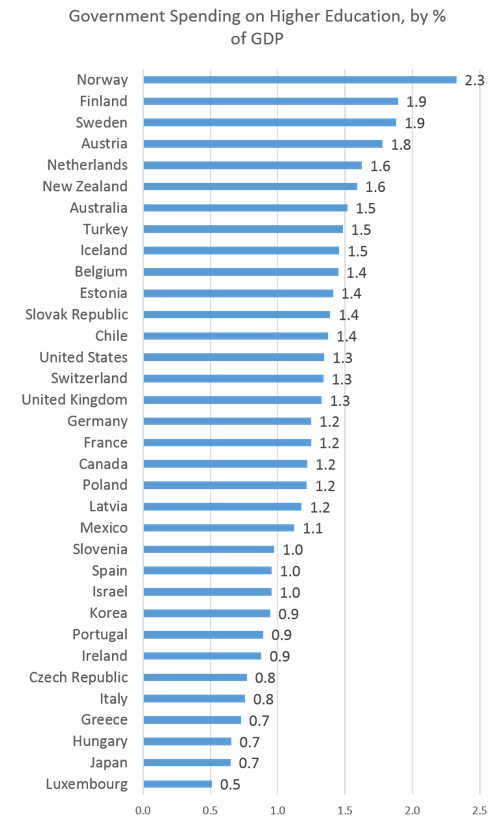Authored by Ryan McMaken via The Mises Institute,
Presidential candidates Bernie Sanders and Elizabeth Warren have both come out in favor in “free” public colleges and universities. The scheme could be funded, as CNN describes it, by “drastic increase in federal spending on higher education.”
Much of the rhetoric around swirling around this issue relies on the idea that government spending on higher education in the United States is significantly lower than most other wealthy countries.
The narrative goes like this:
“everyone knows that Americans are incredibly stingy when it comes to spending on government services. ‘Public spending’ on higher education is much lower here than in Europe and Japan, and because of this, people must spend much more on higher education.”
But here’s the rub: that statement isn’t true. Governments in the United States pay more (as a percentage of GDP) toward higher education than many other so-called “peer” countries.
According to the OECD’s 2018 “Education at a Glance” report, public spending on higher education in the United States is 1.3 percent of GDP. That’s equal to public spending in Switzerland and the United Kingdom. And it’s higher than spending rates found in Germany (1.2), France (1.2), Canada (1.2), Spain (1.0), Italy (0.8), and Japan (0.7).
Source: “Public expenditure on education as a percentage of GDP, total tertiary,” Table C4.1, Education at a Glance, 2018. Similarly, see UNESCO: Government expenditure on education as a percentage of GDP. (http://data.uis.unesco.org/index.aspx?queryid=3373.)
But how can this be, since we’re told constantly how expensive it is to attend a higher education institution in the United States?
One factor is that American colleges and universities spend much more on educating each student – assuming “education” is the proper term here. In the US, adding together both government and private sources together, we find far more funds pouring into US colleges, than is the case elsewhere. According to the OECD, “total expenditure on educational institutions per full-time equivalent student” clocks in at $30,003 in the US. That’s second only to Luxembourg which is off the charts at $48,907. The UK — where residents often complain about the cost of higher education — comes in right behind the US at $26,000. But few other countries even crack the $20,000 mark. Total spending on higher education in France is $16,145. It’s $17,036 in Germany. Higher education institutions in Spain require only $12,605 per student.1
Moreover, what’s driving much of the spending — in terms of both government spending and private-sector spending — is the fact that colleges and universities in America spend far more on administration and ancillary services than higher education institutions elsewhere. Writing for The Atlantic last year, Amanda Ripley noted:
The U.S. ranks No. 1 in the world for spending on student-welfare services such as housing, meals, health care, and transportation, a category of spending that the OECD lumps together under “ancillary services.” All in all, American taxpayers and families spend about $3,370 on these services per student—more than three times the average for the developed world. … One reason for this difference is that American college students are far more likely to live away from home. And living away from home is expensive, with or without a lazy river. Experts say that campuses in Canada and Europe tend to have fewer dormitories and dining halls than campuses in the U.S.
This helps keep costs down. As Marketplace reported back in 2015, “Students in Germany … tend to stay local, so there aren’t any dorms. There are no active student clubs, or big football stadium. And every lecture hall looks huge … All of this translates to savings…” (For more on how “free” European colleges economize, see “‘Free College’ Comes at a Price.”
But it’s not just physical amenities like dorms. Ripley adds:
U.S. colleges spend, relative to other countries, a startling amount of money on their nonteaching staff, according to the OECD data. Some of these people are librarians or career or mental-health counselors who directly benefit students, but many others do tangential jobs that may have more to do with attracting students than with learning. Many U.S. colleges employ armies of fund-raisers, athletic staff, lawyers, admissions and financial-aid officers, diversity-and-inclusion managers, building-operations and maintenance staff, security personnel, transportation workers, and food-service workers.
Oddly, Ripley tries to argue colleges spend too much on amenities because they are market-oriented and compete for students with other colleges.
But, if this were true, why do colleges only compete in terms of adding ever-more opulent services and facilities? Couldn’t they also attract more students by lowering prices?
The fact is colleges don’t compete on prices because, thanks to subsidized student loans, potential students aren’t nearly as price sensitive as they would otherwise be. In a functioning marketplace, highly-priced luxury colleges would lose students to more meat-and-potatoes schools. The result would be declining enrollment at the more expensive schools. But, with so many student-loan dollars available, students can more easily justify — in their minds — taking on debt so they can go to a school with all those amenities Ripley lists.
Regardless of the details of what exactly is being bought at an American college, the fact remains that students aren’t going into debt or finding college “unaffordable” because governments in the US spend so little on higher education.
On the contrary, they spend very large amounts of money on higher education through programs that include direct subsidies to schools, and grants to both students and schools.
As with health care in the US — a sector in which US government spending per capita outpaces most other countries, the facts simply don’t support the idea that “too little government spending” is the cause of high prices.
Indeed, if government agencies in the US really wanted to make an education more affordable, they’d be slashing the “diversity” staff, getting rid of their on-campus housing and dining halls, and privatizing all athletic programs.
The college administrators, of course, would complain that without all the extras, they’ll be unable to attract as many students — who bring with them their precious student loans. This would nonetheless be a boon to the more clever students who are more interested in an education than a four-to-six-year summer camp.
via ZeroHedge News http://bit.ly/2GL4hUJ Tyler Durden

